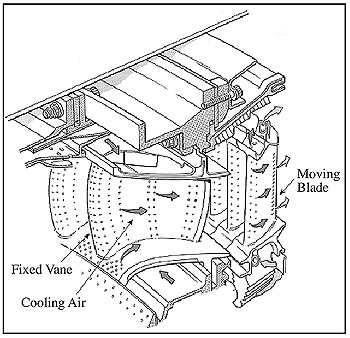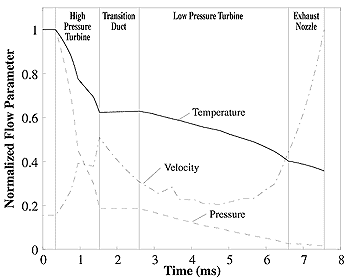7.5.4.3. Longer-Term Technology
Much of the longer term combustion research is now aimed at what is termed
"ultra-low NOx technology." This technology is defined as technology that produces
NOx levels that are no more than 50% of the ICAO CAEP/2 standards. All major
manufacturers of aircraft engines, with the sponsorship of associated government
agencies, are currently pursuing combustor technologies aimed at reducing NOx
emissions to these levels, under operating conditions typical of the next generation
of engines. This approach entails pursuing technology that is relevant to engines
with pressure ratios from current levels (ª30 to 40) to future levels (above
50). The aim is to reduce NOx production in the vicinity of airports and at
subsonic cruise conditions. Two key programs are aimed at large, subsonic, high-pressure
ratio aircraft engines:
- U.S. NASA Advanced Subsonic Technology (AST) Program: Sequential NOx goals
of 50 and 70% reduction below CAEP/2 standards, with comparable reductions
at subsonic cruise; engine SFC reduction of 8-10% over the most recent production
engines by about 2010
- EU-BRITE/EURAM Projects Low NOx I,II,III: Goal of NOx reduction more than
60% below CAEP/2; engine SFC reduction of 8-10% over the most recent production
engines by about 2010.
|

Figure 7-24: Illustration of complex flow passages
and blade cooling schemes in a typical turbine stage (after Rolls Royce, 1992).

Figure 7-25: Typical static temperature and static
pressure histories downstream of the combustor (Lukachko et al., 1998).
|
These programs specify that there must be no compromise in performance, safety,
or any other emissions parameters (smoke, CO, and HC).
Details of combustor technologies are commercially sensitive and are not openly
available. However, three parallel strategies are being pursued. They vary in
their NOx reduction potential and their associated increase in complexity, cost,
and development challenge:
- Reductions in NOx levels close to 50% of CAEP/2 standards are being sought
through the optimization of current single-stage combustor technology. This
approach involves further improvements in fuel injection uniformity, better
fuel/air mixing, reduction in combustor liner coolant flow (making more air
available for combustion), and decreases in hot gas residence time. Such changes
would have minimum impact on engine cost of ownership. The first examples
of this type of technology now exist in manufacturers' product plans for the
next 5 to 10 years.
- Reductions in NOx levels to 50-70% below CAEP/2 standards are being explored
using multi ple burning zones in radial and axial configurations (Figure
7-23). These concepts permit local temperature and residence time in the
combustor to be controlled and optimized at each engine operating condition,
to minimize NOx and other emittants (Bahr, 1992; Segalman et al., 1993). In
low-power operations, a single stage is fueled and optimized for stability.
At high-power conditions, one or both stages,configured for lean burning,
are fueled. Generally, radial staged designs are shorter and lighter but larger
in diameter, making it more difficult to achieve a uniform exit temperature
profile at off-design conditions. They are also more difficult to cool. Axial
staged systems are longer and have a larger number of fuel injectors. In both
cases, the increased complexity and weight of these combustors is expected
to increase the cost of ownership, as described by DuBell (1995). A major
effort is needed to minimize the cost, complexity, weight, and performance
of these concepts. Reduction in NOx levels to 85-90% below CAEP/2 standards
are focused on emissions from supersonic aircraft at cruise conditions. Such
work presently forms part of the U.S. supersonic transport program. Combustors
known as lean premixing prevaporizing (LPP) and rich burn quick quench (RBQQ)
are being studied. In the former, the burning zone is fed with a lean and
homogeneous fuel/air mixture. Premixing and prevaporizing takes place in a
premix duct outside the combustor. The RBQQ combustor consists of three zones:
A primary rich burning zone; a dilution zone, to rapidly reduce the rich mixture
to a lean one without recirculating dilution air into the primary zone; and
a lean reburning zone (DuBell, 1995). These combustors uniquely apply to the
supersonic engine with its relatively low engine pressure ratio and its requirement
for long periods at a single, high-speed cruise operating condition. Application
of these concepts to future subsonic engines would pose special problems because
of higher pressure ratios. For example, the LPP combustor will have to overcome
the greater risk, at very high pressures, of "flashback" or upstream burning-which,
if undetected, could damage the combustor. Similarly, the RBQQ combustor-with
its high fuel concentration in the primary burning zone-may well result in
the generation of large amounts of soot and smoke in high-pressure operations.
However, some of the features found in these concepts may be suitable for
higher pressure ratio subsonic engines. Partial premixing, coupled with moderately
rich sector burning, represents one such concept. Multiple burning zones,
together with variable geometry to control local fuel/air ratios, would be
another. A concept incorporating several of these features (shown in Figure
7-23b) is being pursued under the European Union's Targeted Research Action
"Efficient and Environmentally Friendly Aero-Engines." A radially staged configuration
currently under "main" phase development (LOWNOxIII) combines an RBQQ candidate
pilot injector with a premixing main zone injector. This concept might provide
low NOx emissions with acceptable operational capabilities at LTO and cruise
conditions of subsonic aircraft (Zarzalis et al., 1995).
7.5.5. Future Technology Scenarios
As part of the preliminary work associated with this report, industry was asked
to consider what advances in technology might be applicable for aircraft in
the year 2050. Numerous projections were made by an expert group from the aeronautical
industry (engine, airframe, and aerospace manufacturers). The group provided
their best judgments of fuel efficiency and NOx technology scenarios for the
year 2050 (ICCAIA, 1997f) to the ICAO Committee on Aviation Environmental Protection
Forecasting and Economic Support Group (FESG) for use in Chapter
9 of this report. The assumptions for the 2050 scenarios were as follows:
- Continued demand for worldwide commercial/regional/ general aviation aircraft
- Technology advancement to be addressed for all engine sizes
- Unrestricted kerosene availability
- Development time and operational life of modern aircraft = 40-50 years
- All airworthiness requirements achievable
- Economically viable
- No impact on noise
- Possible NOx reduction scenarios.
Chapter 9 of this report considers the conclusions
of the group in conjunction with FESG traffic scenario projections. Together,
these considerations take account not only of long-term demand but also of fuel
burn and emissions (see Chapter 9). The latter two depend
on three factors:
- Airframe technology developments (discussed in Sections
7.2 and 7.3)
- Trends in engine design (discussed in Section 7.4)
- Combustion system development-in particular NOx reduction scenarios, based
in one case on the best near-term combustor technology and in the other on
longer term NOx reduction combustor technology (discussed in Sections
7.5.3 and 7.5.4, respectively).
The benefits arising from the first item influence projections in terms of
fuel efficiency alone. The other two items take into account the net effects
of cycle changes and emissions reductions strategies. Two potential long-term
aircraft technology scenarios emerged from these deliberations. These scenarios
are summarized in Table 7-6.
The outcome of these deliberations is that a basis now exists for the development
and ongoing monitoring of future research strategies as air transport and concern
about its environmental impact continues to grow.
7.5.6. Summary of Key Points Relating to Combustion Technology
Several important conclusions can be drawn from the present assessment of combustion
technology in relation to emissions production and control:
- Research and development programs over the past 25 years have provided
a basis for vastly improved combustion systems for modern aircraft engines.
Current combustion systems achieve virtually 100% energy conversion efficiency
at virtually all power settings. Better fuel/air mixing processes, liner cooling
techniques, and materials have contributed to this progress. The levels of
unburned products, such as CO and HC, from engines are now very low, and visible
smoke levels are now under control.
- Reductions in CO2 depend primarily on engine cycle, not the combustor.
The role of the combustor is to ensure that the demands of the more fuel-efficient
cycle (low CO2) are met without compromising engine performance.
- The more fuel-efficient engines, with their high bypass ratios, introduced
in the 1970s and 1980s reduced CO2, HC, and CO emissions but increased NOx.
Although technological improvements have constrained the rise in NOx, it has
become clear that more substantial reductions require more radical solutions
(with associated risks and penalties).
- Technology that has reduced NOx emissions at high power, near the ground,
also reduces NOx at high altitude, though not necessarily by the same amount.
- Current research goals are to achieve NOx levels of 50% of current standards
in 5 to 10 years. Work is also in progress to achieve NOx levels 50-70% below
current NOx standards using more advanced, staged combustors.
- Although there has been a marked improvement in the measurement and assessment
of trace species and aerosols emerging from engines, knowledge about their
formation-hence our ability to control them-is extremely limited.
|